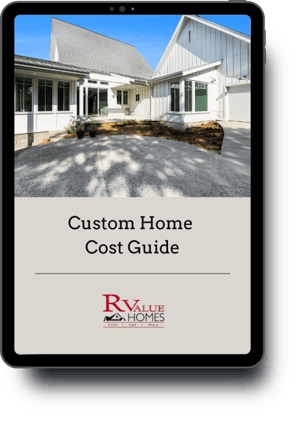3 Min Read
What is an Airtight Custom Home and Do You Need One in Grand Rapids?
If you haven’t considered an airtight home for your custom build, you may want to reevaluate, as there is a long list of benefits, including energy efficiency and personal comfort. At R-Value Homes, our time-tested process follows the principle of “build tight, ventilate right”. That is, we eliminate or reduce all air leaks in the home, and use the HVAC (Heating, Ventilation, Air Conditioning) system to bring in just the right amount of fresh air.
.png?width=972&name=What%20is%20an%20Airtight%20Custom%20Home%20and%20Do%20You%20Need%20One%20in%20Grand%20Rapids_%20(1).png)
Traditional homes leak massive amounts of air. Fresh air is plentiful, but it isn’t very much fun to heat outside air, much less pay for it. And not all fresh air is created equal. During the winter months, air that leaks in is dry. It induces static electricity and causes bloody noses and itchy skin. Ugh!
Building an "airtight" home has many benefits; including lower energy usage, healthier air, improved durability, and greater comfort. But a completely airtight building envelope creates a problem: a lack of fresh air.
Enthalpy Recovery Ventilators (ERV) and Heat Recovery Ventilators (HRV) solve this problem. The differences are a bit too vast to share here, but for our purposes today, they do the same thing: bring fresh and clean air into the home, while removing stale and dirty air.
What an E/HRV Does
An E/HRV is connected to 4 ducts. One brings fresh air from outside, passes it through a heat exchanger, then the second duct delivers it into the home. The third duct takes the stale air from the home and passes it through the heat exchanger, then the fourth duct exhausts it outside.
The heat exchanger “core” is where the magic happens. As the stream of incoming fresh air passes through the core, it is warmed by the stream of outgoing stale air; all without mixing the airstreams. The core acts as a radiator to exchange heat energy. (in an ERV, some humidity is also exchanged).
Our Balanced Ventilation Strategy
We believe this process should work independently of the furnace and air conditioning. In an R-Value home, you will find the E/HRV in the mechanical room. Since the ducting is separate from that of the air handler, the furnace fan doesn’t need to run when the E/HRV is on (and the E/HRV is on all the time for at least the first year!). Furthermore, dedicated ducting for the E/HRV ensures we can remove stale air at its source, and deliver fresh air in the rooms where it is most needed.
The E/HRV typically removes stale air from bathrooms, which helps dry the steam that accumulates when using your showers and keeps them smelling fresh. Depending on the home and occupants, the E/HRV may also be used to remove stale air from laundry rooms and/or kitchens.
Fresh air delivery is often made to a common space of the home, then the pressure difference created by exhausting the stale air naturally draws the fresh air throughout the home.
More E/HRV Benefits
- Quiet: Did we mention how quiet these things are? Many of us are accustomed to bath fans so loud that we think nobody can hear us sing in the shower (spoiler alert: they can hear you)! But an E/HRV running on low is barely discernible. In fact, an E/HRV on high/boost mode is still quieter than the best bath fans available today!
- Perfect ventilation: Consistent ventilation keeps your mind functioning properly (perfect for when we are all stuck at home due to Covid).
- Allergen reduction: And since all incoming air is filtered, those of us with environmental allergies and sensitivities realize improved health.
Balanced Ventilation
Some builders rely on exhaust-only ventilation; running a quiet bath fan on a schedule to remove stale air. The stale air that is removed is replaced through air leaks in the home. These leaks often come through the garage, where we warm our cars up in the winter (carbon monoxide, anyone?). In other words, this is NOT a reliable source of fresh air. Furthermore, the air is unfiltered, dry, and must be heated. Finally, leaking air means leaking moisture—as the air carries moisture with it during the summer months. Whenever building materials get wet, mold and rot are distinct possibilities.
How Do I Know If My Home Is Airtight?
Blower Door Test
A Blower Door test measures air leakage. First, a powerful fan is sealed into an exterior door. With all other entrances closed, this fan is the sole entry and exit point for air. By creating a pressure differential, air from the outside enters the home by any available means. This calibrated fan can measure how much extra air is moving through the structure and therefore measure how much air is leaking into the home. R-Value Homes conducts this test with each build to ensure that we have created the airtight structure we promise.
Infrared Cameras
This step may be needed if the blower door test reveals significant air leaks or if there is another reason to believe there may be other energy inefficiencies. In this step, a heat-sensitive camera is used to detect air leakage or poor insulation.
Build Your Airtight Custom Home Today
The ongoing costs of an exhaust-only strategy are not only seen on your energy bill; your health and comfort but also go out the window (dad joke intended). Yes, balanced ventilation has a higher initial cost, but the cost of NOT using an E/HRV is far greater.
It bears repeating: build tight, ventilate right.
Here at R-Value Homes, you benefit from our decades of industry experience. Owner Jake Vierzen has developed deep insights into the overlapping benefits of energy efficiency and custom home design, becoming an expert in ICF home construction. With these insights, he has turned R-Value Homes into a local leader in matching custom designs with the high energy efficiency demands of modern families. Get in touch today to learn how R-Value Homes can build your sustainable dream home and enhance your life for generations to come!





